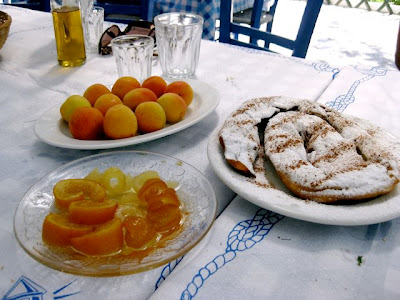Milos Island, Cyclades - home of Venus de Milo (the French nicked it!) - she once adorned a now ruined temple on the hill above this fishing village. They are still looking for her missing arms! Fancy a dip?
Maybe it just has a real resonance for me because I too went to Greece and fell in love - with the varied landscapes, the romance of being on the edge of Europe and the beginning of the East, the history, the marvelous island journeys, the best swimming in the world, THE FOOD and, most of all the Greeks. I agree with Miller when he says in the book "I like a good Greek meal better than a good French meal, even though it be heresy to admit it"
A good Greek meal - gigantes, bread, calamari, Greek salad
 |
| Fresh sardines with a fennel and carrot salad, Milos |
 |
| Maria's bougatsa, candied citrus and fresh apricots, Milos |
Oh, and did I mention the cakes and pastries, either dripping with spiced and citrusy honey or crispy filo stuffed with sweetened stuffed cheeses and nuts(bougatsa) - and that's for breakfast! And the yoghurt, the dips, mezze plates, Sifnos chick peas soup, Symi shrimps,
the bread, the TASTE of the tomatoes, sun kissed apricots, peaches and figs, local olives, manouri cheese, wild greens, rose petal jam..................!!
Back streets of Milos
Gigantes Plaki Γίγαντες πλακί500gm lima/butter beans, soaked overnight and cooked until tender (you can used canned).
NOTE: Don't add salt when you are cooking the beans from scratch - it makes them tough - add it afterwards.
200ml olive oil (this may seem a lot, but the Greeks use a lot of olive oil when cooking)
2 onions, finely chopped
2 carrots, finely chopped
1 celery heart or fennel heart
3 cloves of garlic, crushed
2 bay leaves
thyme, one sprig
small bunch of dill or fennel tops
1 kilo very ripe fresh tomatoes or equivalent canned
sea salt and black pepper
1tbs brown sugar
1tbs balsamic vinegar
 |
| Gigantes Plaki |
1. Heat oil in ovenproof casserole.
2. Add onions and saute for 5 mins.
3. Add celery, carrots, garlic and saute until soft.
4. Add tomatoes, bay leaves, thyme and salt and pepper and cook for one hour.
5. Remove bay leaves and thyme and stick blend until pureed into a thick sauce.
(Blending the sauce is not always done in Greece, instead they grate the onion and chop everything else really finely. This is quicker and coats the beans better)
6. Add cooked beans, brown sugar and balsamic and bunch of chopped dill (this is secret ingredient!) and cook in moderate oven, about 180C (with the lid on) for a further 1 hour.
Serve drizzled with olive oil and extra fresh dill or fennel.
 |
| Milos - the best swimming in the world! |
"It is not an exaggeration to say that peace and happiness begin, geographically, where garlic is used in cooking" X. Marcel Boulestin 1878-1943, French chef and restaurateur - the first television chef.
Taj - 9 months - enjoying his gigantes. This is a great dish to give to children being a good source of vegetable protein - along with all other legumes like peas, beans and lentils.




2 comments:
I read elsewhere that the gigantic Greek bean is more like a runner than any other bean.
I'm about to try a few overgrown beans and see if it cooks more like the Greek than tinned Lima or butter beans.
Dear Fran, the Greeks certainly do cook up fresh green beans with tomato - this is a dish called FASOLAKIA - slow cooked until really soft and often served with crumbled feta on top - it's really yummy. However, GIGANTES is a different dish always made with dried butter beans or fava beans and cooked for much longer. FASOLAKIA is made with onion cooked in olive oil, chopped fresh tomato, parsley (or dill) and fresh green beans - the Greeks usually use a flat or runner bean. Enjoy!
Post a Comment